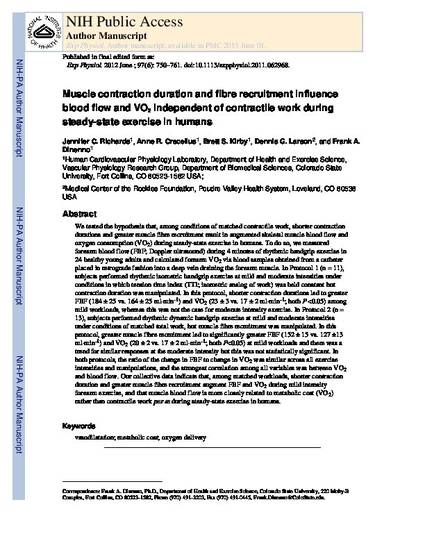
We tested the hypothesis that, among conditions of matched contractile work, shorter contraction durations and greater muscle fibre recruitment result in augmented skeletal muscle blood flow and oxygen consumption (O2) during steady-state exercise in humans. To do so, we measured forearm blood flow (FBF; Doppler ultrasound) during 4 minutes of rhythmic handgrip exercise in 24 healthy young adults and calculated forearm O2 via blood samples obtained from a catheter placed in retrograde fashion into a deep vein draining the forearm muscle. In Protocol 1 (n = 11), subjects performed rhythmic isometric handgrip exercise at mild and moderate intensities under conditions in which tension time index (TTI; isometric analog of work) was held constant but contraction duration was manipulated. In this protocol, shorter contraction durations led to greater FBF (184 ± 25 vs. 164 ± 25 ml·min-1) and O2 (23 ± 3 vs. 17 ± 2 ml·min-1; both PPper se during steady-state exercise in humans.
- vasodilatation,
- vasodilation,
- metabolic cost,
- oxygen delivery
Available at: http://works.bepress.com/anne_crecelius/6/

This is the peer-reviewed version of the following article:
Richards, J.C., A.R. Crecelius, B.S. Kirby, D.G. Larson and F.A. Dinenno. “Muscle contraction duration and fibre recruitment influence blood flow and VO2 independent of contractile work during steady-state exercise in humans.” Exp Physiol. 97:750-761. 2012.
This article may be used for non-commercial purposes in accordance with Wiley terms and conditions for self-archiving. Article has been published and is available in its final form online.
The article available in the repository is the author's accepted manuscript; the version of record may contain minor differences that have come about in the copy editing and layout processes.